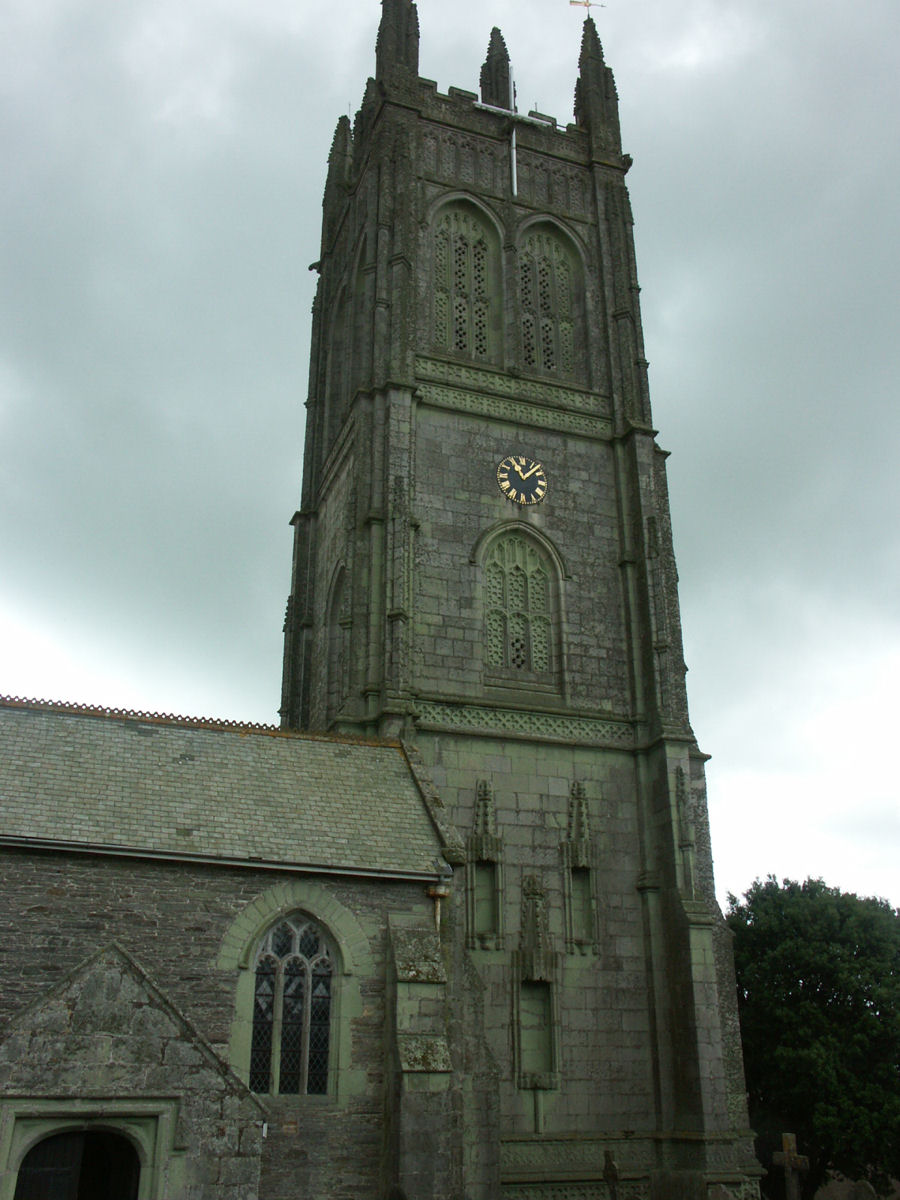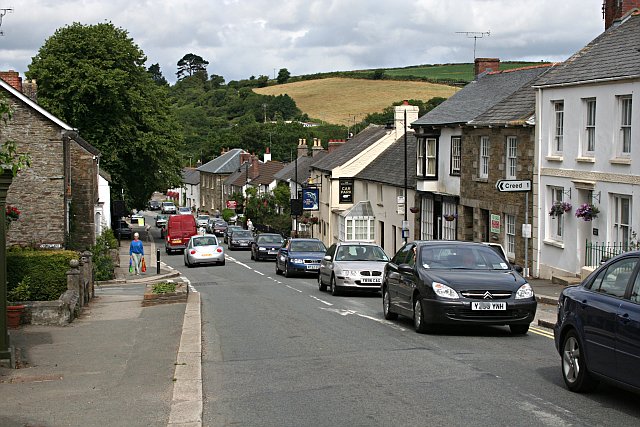|
Probus, Cornwall
Probus ('' Cornish: Lannbrobus'') is a civil parish and village in Cornwall, England, in the United Kingdom. It has the tallest church tower in Cornwall. The tower is high, and richly decorated with carvings. The place name originates from the church's dedication to Saint Probus. The parish population at the 2011 census was 2,299, whereas the ward population taken at the same census was 3,953. History There was a monastery here before the Norman Conquest which continued to exist until the reign of Henry I. King Henry gave the church of Probus to Exeter Cathedral and the clergy of Probus thereafter were a dean and five canons (the deanery was abolished in 1268 and the canonries in 1549). The first vicar was instituted in 1312; the parish had dependent chapelries at Cornelly and Merther. The church was built mainly in the 15th century but the tower was still under construction in 1523. In the church is the brass of John Wulvedon and his wife, 1512. In the early years of the 19th ce ... [...More Info...] [...Related Items...] OR: [Wikipedia] [Google] [Baidu] |
Probus St Probus And St Grace 001
Probus may refer to: People * Marcus Valerius Probus (c. 20/30–105 AD), Roman grammarian * Marcus Pomponius Maecius Probus, consul in 228 * Probus (emperor), Roman Emperor (276–282) * Probus of Byzantium (–306), Bishop of Byzantium from 293 to 306 * Saint Probus of Side, martyr of the Diocletian persecution (c. 304 AD) * Sextus Claudius Petronius Probus (''floruit'' 358–390), a powerful Roman senator of the fourth century * Anicius Petronius Probus, Roman consul in 406 * Probus, martyr of 437 * Probus (son of Magnus), Gallo-Roman senator of the fifth century * Anicius Probus (''fl.'' 459), a Roman senator of the 5th century * Probus (consul 502), consul in 502 * Probus (consul 513), Flavius Probus, consul in 513 * Anastasius (consul 517), Flavius Anastasius Paulus Probus Sabinianus Pompeius, consul in 517 * Flavius Anicius Probus Iunior, consul in 525 * Rufius Gennadius Probus Orestes, consul in 530 * Henryk IV Probus (c. 1258–1290), High Duke of Polan * Probus ... [...More Info...] [...Related Items...] OR: [Wikipedia] [Google] [Baidu] |
Trewithen House
Trewithen House is a Georgian country house in Probus, Cornwall, England. The Palladian house was built by London-based architect Thomas Edwards in 1723. The house is listed Grade I on the National Heritage List for England, and its gardens are Grade II* listed on the Register of Historic Parks and Gardens. History Wealthy landowner and lawyer Phillip Hawkins purchased the estate in 1715. He ordered London-based architect Thomas Edwards to build the Palladian house in 1723. It was later revised by Edwards in around 1738 and by Sir Robert Taylor in the 1750-1760s. Architecture The house is built from granite ashlar, Pentewan stone ashlar and stucco, and features hipped slate roofs and rendered stacks. The central doorcase is arched with a pulvinated frieze, and contains an 18th-century central panelled door with sidelights. In the interior, the central east room of the house is panelled with pine wood, while the central south room features arcaded screens and Roman-style ... [...More Info...] [...Related Items...] OR: [Wikipedia] [Google] [Baidu] |
Ceanothus
''Ceanothus'' is a genus of about 50–60 species of nitrogen-fixing shrubs and small trees in the buckthorn family (Rhamnaceae). Common names for members of this genus are buckbrush, California lilac, soap bush, or just ceanothus. ''"Ceanothus"'' comes from grc, κεάνωθος (''keanōthos''), which was applied by Theophrastus (371–287 BC) to an Old World plant believed to be ''Cirsium arvense''. The genus is native to North America with the highest diversity on the western coast. Some species (e.g., '' C. americanus'') are restricted to the eastern United States and southeast Canada, and others (e.g., '' C. caeruleus'') extend as far south as Guatemala. Most are shrubs tall, but '' C. arboreus'' and '' C. thyrsiflorus'', both native to California, can be small multi-trunked trees up to tall. Taxonomy and etymology There are two subgenera within this genus: ''Ceanothus'' and ''Cerastes''. The former clade is less drought-resistant, having bigger leaves. The evolution of ... [...More Info...] [...Related Items...] OR: [Wikipedia] [Google] [Baidu] |
Camellia
''Camellia'' (pronounced or ) is a genus of flowering plants in the family Theaceae. They are found in eastern and southern Asia, from the Himalayas east to Japan and Indonesia. There are more than 220 described species, with some controversy over the exact number, and also around 3,000 hybrids. The genus was named by Linnaeus after the Jesuit botanist Georg Joseph Kamel, who worked in the Philippines and described a species of camellia (although Linnaeus did not refer to Kamel's account when discussing the genus). Of economic importance in East Asia, Southeast Asia, and the Indian subcontinent, leaves of '' C. sinensis'' are processed to create the popular beverage tea. The ornamental '' C. japonica'', '' C. sasanqua'' and their hybrids are the source of hundreds of garden cultivars. '' C. oleifera'' produces tea seed oil, used in cooking and cosmetics. Descriptions Camellias are evergreen shrubs or small trees up to tall. Their leaves are alternately arranged, ... [...More Info...] [...Related Items...] OR: [Wikipedia] [Google] [Baidu] |
Trewithen
Trewithen House is a Georgian country house in Probus, Cornwall, England. The Palladian house was built by London-based architect Thomas Edwards in 1723. The house is listed Grade I on the National Heritage List for England, and its gardens are Grade II* listed on the Register of Historic Parks and Gardens. History Wealthy landowner and lawyer Phillip Hawkins purchased the estate in 1715. He ordered London-based architect Thomas Edwards to build the Palladian house in 1723. It was later revised by Edwards in around 1738 and by Sir Robert Taylor in the 1750-1760s. Architecture The house is built from granite ashlar, Pentewan stone ashlar and stucco, and features hipped slate roofs and rendered stacks. The central doorcase is arched with a pulvinated frieze, and contains an 18th-century central panelled door with sidelights. In the interior, the central east room of the house is panelled with pine wood, while the central south room features arcaded screens and Roman-style ... [...More Info...] [...Related Items...] OR: [Wikipedia] [Google] [Baidu] |
Probus Club
Probus Clubs are clubs for retired or semi-retired people from all walks of life and may include business or professional people. The movement operates worldwide. Organisation PROBUS is a local, national, and international association of retired people who come together in non-political, non-sectarian, non-profit, autonomous clubs which provide regular opportunities for members to meet others in similar circumstances, with similar levels of interest, make new friends, and maintain and expand their interests. Probus Clubs can be made up of men, women or be mixed (men and women) clubs. It is normal for the spouses of club members and widows of former members to be encouraged to participate in the social activities. In some places Rotary Clubs sponsor Probus Clubs but many clubs are sponsored by other Probus Clubs. By 2018, there were over 400,000 members in approximately 4,000 Probus clubs worldwide. History The Probus Club movement was formed in the United Kingdom in 1965. ... [...More Info...] [...Related Items...] OR: [Wikipedia] [Google] [Baidu] |
St Austell Brewery
St Austell Brewery is a brewery founded in 1851 by Walter Hicks in St Austell, Cornwall, England. History Originally named ''Walter Hicks & Co: brewers and wine merchants'', the brewery company was renamed St Austell Brewery and significantly expanded by Hicks' daughter Hester Parnall (1868-1939), who became a Director in 1911. She took over running the company on her father's death in 1916, and added nearly 80 pubs and hotels to the brewery's holdings, becoming known for "''ruling the company with the grace of a duchess combined with the aplomb of a successful businessman''". The brewery's flagship beer is Tribute Ale, which accounts for around 80% of sales. Other popular ales include Proper Job, Tinner's Ale and Duchy Bitter. On 1 July 2016 St Austell Brewery acquired Bath Ales. In March 2017 a multi-million pound investment in a new brewery and larger bottling and canning facilities at Bath Ales was announced. Chief executive, James Staughton, described the rationale ... [...More Info...] [...Related Items...] OR: [Wikipedia] [Google] [Baidu] |
A390 Road
The A390 is a road in Cornwall and Devon, England. It runs from Tavistock to north west of the city of Truro. Starting in Tavistock, it heads south-westwards towards Liskeard, crossing over the River Tamar and into Cornwall, then through Gunnislake and Callington. Immediately before Liskeard, it merges with the A38 north of the town. It diverges from the A38 at Dobwalls, where it then runs in a south-westerly direction to Truro via Lostwithiel, St. Blazey, and St Austell. It then forms an upside down elongated square loop, and bypasses Truro City Centre. It then heads north west out of the city, where it forms the main corridor into Truro from the west. It passes the Royal Cornwall Hospital and skirts the village of Threemilestone, before linking up with the A30 road at Chiverton Cross, where the A390 terminates. Chiverton Cross is where the A390 trunk road from Truro and the B3277 to St Agnes meet the east–west A30 trunk road. Before the A390 was rerouted away from Chac ... [...More Info...] [...Related Items...] OR: [Wikipedia] [Google] [Baidu] |
Probus And Ladock Halt
There are seventeen disused railway stations on the Cornish Main Line between Plymouth in Devon and Penzance in Cornwall, England. The remains of nine of these can be seen from passing trains. While a number of these were closed following the so-called "Beeching Axe" in the 1960s, many of them had been closed much earlier, the traffic for which they had been built failing to materialise. Background The railway from Plymouth to Truro was opened by the Cornwall Railway on 4 May 1859, where it joined up with the West Cornwall Railway which had been completed from there to Penzance on 16 April 1855. The section from Carn Brea to Angarrack dates back to the Hayle Railway, opened on 23 December 1837. It now forms Network Rail's Cornish Main Line. Plymouth to Truro Plymouth Millbay The trains of the South Devon Railway finally reached the town of Plymouth on 2 April 1849. Docks were opened adjacent to the station and a new headquarters office was built next door. The station was e ... [...More Info...] [...Related Items...] OR: [Wikipedia] [Google] [Baidu] |
Cornish Main Line
The Cornish Main Line ( kw, Penn-hyns-horn Kernow) is a railway line in Cornwall and Devon in the United Kingdom. It runs from Penzance to Plymouth, crossing from Cornwall into Devon over the famous Royal Albert Bridge at Saltash. It directly serves Truro, St Austell, Bodmin (by a Parkway station) and Liskeard. It forms the backbone for rail services in Cornwall and there are branches off it which serve St Ives, Falmouth, Newquay and Looe. The main line also carries direct trains to and from London, Birmingham, Cardiff, Manchester, the north of England and Scotland. It is the southernmost railway line in the United Kingdom and the westernmost in England. History The Cornish Main Line was originally built by two separate railway companies, the West Cornwall Railway between Truro and Penzance, opened in 1852, and the Cornwall Railway between Plymouth and a separate station in Truro, opened in 1859. The West Cornwall Railway was itself based on the Hayle Railway, opened in ... [...More Info...] [...Related Items...] OR: [Wikipedia] [Google] [Baidu] |
The Manor House, Golden - Scene Of St Cuthbert's Arrest - Geograph
''The'' () is a grammatical article in English, denoting persons or things that are already or about to be mentioned, under discussion, implied or otherwise presumed familiar to listeners, readers, or speakers. It is the definite article in English. ''The'' is the most frequently used word in the English language; studies and analyses of texts have found it to account for seven percent of all printed English-language words. It is derived from gendered articles in Old English which combined in Middle English and now has a single form used with nouns of any gender. The word can be used with both singular and plural nouns, and with a noun that starts with any letter. This is different from many other languages, which have different forms of the definite article for different genders or numbers. Pronunciation In most dialects, "the" is pronounced as (with the voiced dental fricative followed by a schwa) when followed by a consonant sound, and as (homophone of the archaic pr ... [...More Info...] [...Related Items...] OR: [Wikipedia] [Google] [Baidu] |








.png)